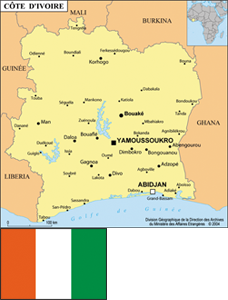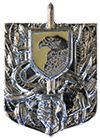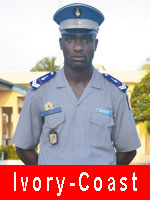
National Gendarmerie of Côte d’Ivoire
|
1960 Ministry of attachment: Ministère de la Défense Workforce: 18 000 Superior Commander: Général Nicolas Kouakou Address: BP V 21, ABIDJAN (Côte d’Ivoire) Tél.: (225) 20 219758 Fax: (225) 20 210873 Email: secomgend.rci@gmail.com Communication service: Lieutenant OUATTARA Zana Djakaridja Tél. : (225) 20219577 Email: ozanadjak@gmail.com 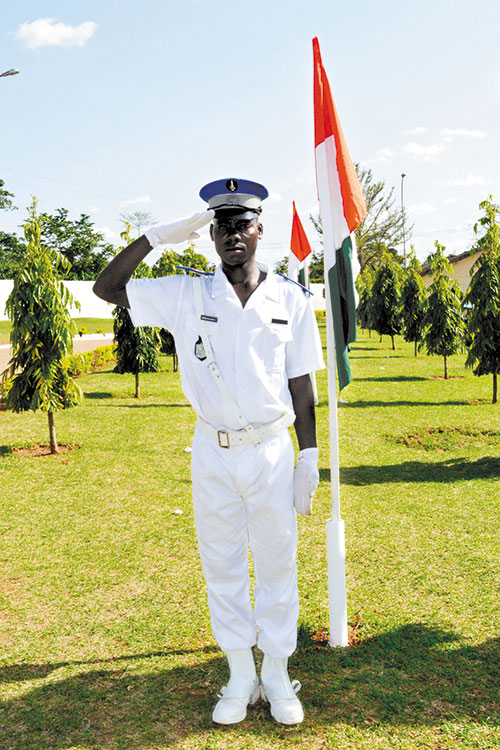
|
History
Before the independence, the French Gendarmerie is present in the Ivorian colony from the beginning of the 1930s. The first brigade is created in Abidjan in 1932. Other brigades are afterward implanted along the railroad network (Agboville, Dimbokro, etc.) in order to prevent possible acts of sabotage before the swarming in the main cities of the colony. Year 1946 sees the creation of the Squadron 1/1, mother of the anti-riot police units and based in the barracks of Agban, always in Abidjan.
From 1958, under the community regime, the French Gendarmerie supervises the first elements of the Ivorian Republican guard, police force, essentially intended for the maintenance of law and order.
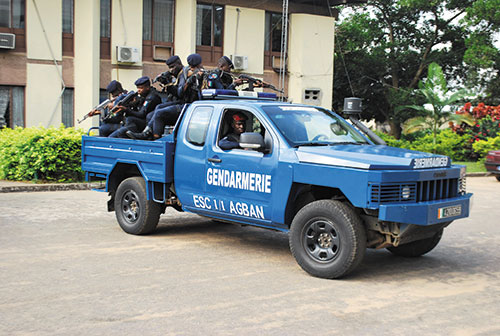
In 1960, in the independence advent, the Republican Guard, strong of 500 men, first armed force exclusively composed of nationals, moved in National Gendarmerie by being inspired by the French model and adopting the slogan "Pro patria, pro lege" ("For the homeland, for the law").
His first commander, Captain Moussa Sanon, has 4 companies of departmental Gendarmerie gathering 54 brigades and of 4 platoons of mobile gendarmes. In 1961, a Gendarmerie school is created in Abidjan with the aim of the fast training of the gendarme’s body. In 1979, with the creation of the armoured squadron, the Ivorian Gendarmerie is the first one of the continent to be equipped with VAB ("Véhicule de l’Avant Blindé" in French or Armoured vehicle). Other specialized units are setting up during the next years: the National Gendarmerie Intervention Unit (NGIU) in 1981, the Gendarmerie Dog Centre in the Bouaké Air Force base in 1985, the Airport Security Group (ASG) in 1990 and the Group of Harbour Security Group (ASG) in 1992. From 2002, the Ivory Coast National Gendarmerie is confronted with the "Ivoirité" crisis and with a politico-military crises moving into war civil which divides the country into two parts. The Ivory Coast gendarmerie slogan "Pro Patria, Pro Lege" – "For the homeland, for the law" - shows the double commitment of the Gendarmerie in the service of the Nation and of the Law.
Organization
The Gendarmerie has a vertical organization to two levels of responsibility: The High Command, the Central organ, and the Territorial structures.
A reform of the organization of the Armed Forces and the National Gendarmerie is in progress. It should lead to the creation of 4 Gendarmerie regions located in Abidjan, Bouaké, Korhogo and Daloa. Each Gendarmerie region should produce a Anti-riot Police legion.
Central Organization
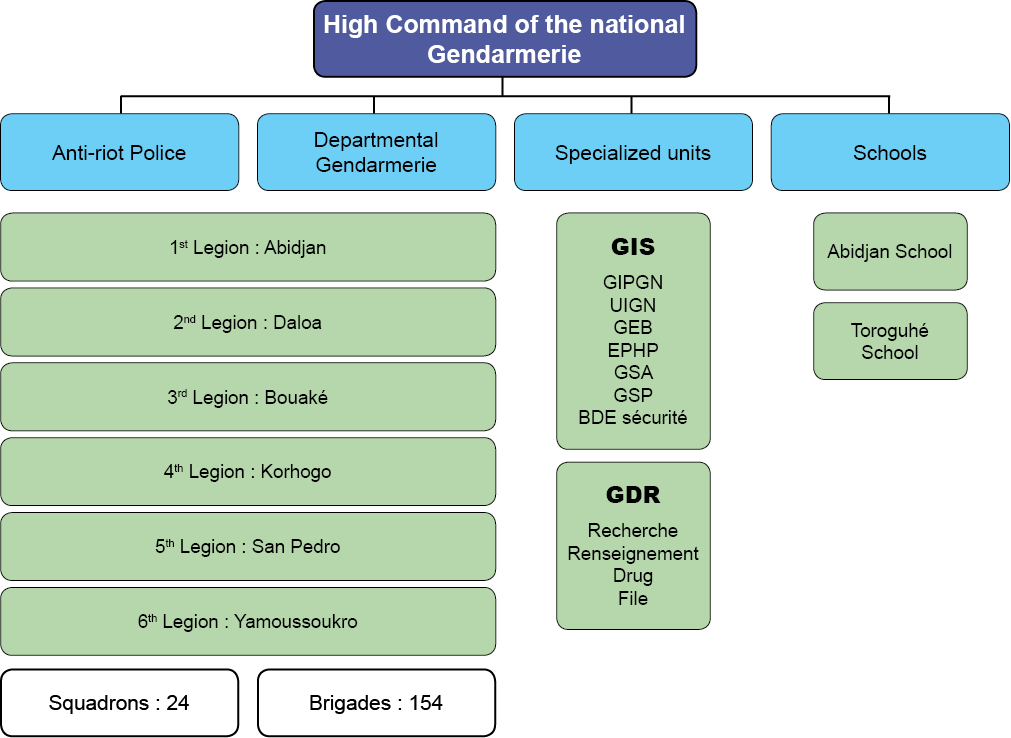
The High Command is organized in offices:
• the Organization Employment Office (OEO );
• the Human Resources Office (HRO);
• the Logistic Office (LOG.O);
• the Telecommunications and Computing Office (TCO);
• the Administrative and Technical Centre of the Gendarmerie (ATCG).
The High commander is assisted by a general officer, the High commander in the second and has a cabinet.
The High Command of the Ivory Coast National Gendarmerie is located in the Plateau district, the Abidjan business centre, and economic capital of Ivory Coast.
The schools of Gendarmerie (both Abidjan and Toroguhé Non-commissioned officers’ training schools, the senior officers application course of Abidjan), the units forming bodies’ as the group of documentation and researches or the group of intervention and security are directly placed under the authority of the High Commander.
Territorial organization
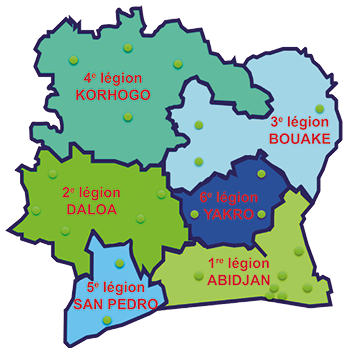
At the territorial plan level, the Gendarmerie is organized in 7 legions, themselves declining in departmental Gendarmerie companies and in mobile gendarmes’ platoons. With the exception of Abidjan, which includes a mobile corps/legion of gendarmes (Called "Légion de gendarmerie mobile") and a departmental corps/legion of gendarmes (Called "Légion de gendarmerie départementale"), the inside country "Légions" include at the same time mobile and departmental units.
The National Gendarmerie trainings are distributed over all the Ivory Coast Republic territory within the framework of the administrative and judicial organization. The departmental Gendarmerie includes:
• 7 "légions" or "Legions". With the exception of Abidjan which includes a mobile and a departmental legion of gendarmes, the inside country legion are grouping together mobile and departmental units at the same time;
• 24 companies;
• 154 territorial brigades.
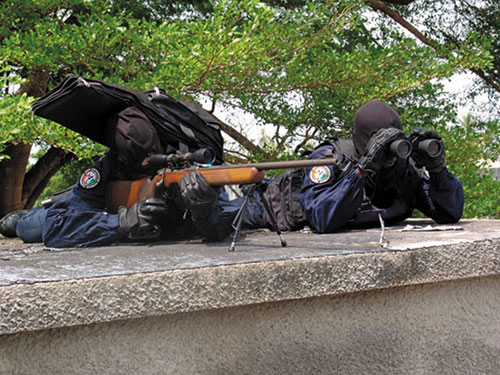
Specialized Formations
• The anti-riot police is dedicated to the preservation and the restoring of the order. It constitutes the frame of the internal defence. It accounts 22 squadrons.
• The Armoured Squadron Group (ASG).
• The National Gendarmerie Intervention Unit (NGIU), inspired by the French GIGN.
• The High Personalities Protection Squadron (HPPS).
• The Research Section (For Criminal Investigation) (RS).
• The Harbour Security Group (HSG).
• The Security Brigade.
Missions
The Ivory Coast National Gendarmerie is a military force established in order to watch over the public security, the maintenance of law and order and the execution of the laws, with the aim of protecting institutions, people and properties. Placed under the direct authority of Minister of Defence, it carries out three types of mission:
• the "Civilian" missions: Administrative police and judicial police/Criminal Investigation;
• the "Military" missions: Military police, operational defence of the territory;
• diverse missions: As, for example, a request for assistance.
Staff
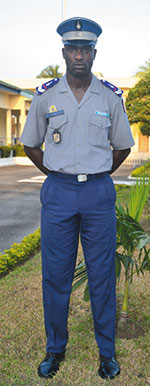 The Gendarmerie has a strength of 18 000 Men among which 500 officers.
The Gendarmerie has a strength of 18 000 Men among which 500 officers.
The future senior officers are recruited according to three ways:
• the direct recruitment intended for the young officers coming from the land forces, the Navy or the Air Force active officer’s training schools;
• the semi-direct competition for the former Gendarmerie non-commissioned officers;
• the officer’s rank aptitude for the non-commissioned officers of the warrant officer or chief warrant officer’s ranks.
The officers receive mainly their basic training in Ivory Coast. However, some are trained in friendly countries as France, Senegal, Morocco and Benin.
The non-commissioned officers are recruited through competitions organized by the Ministry of Defence. They make a two-year schooling in the Abidjan or Toroguhé gendarmerie school. On the judicial plan, the servicemen of the Gendarmerie are officials empowered to make arrests ("Officier de Police Judiciaire" or OPJ in French) or judicial policeman ("Agent de Police Judiciaire" or APJ in French).
The first feminine non-commissioned officers are recruited from 2015. The Gendarmerie does not count conscripts of contingent in its ranks.
The National Gendarmerie is characterized by its barracks presence on the whole territory sheltering the units and in the majority of the cases the staff’s families.
Training institutions
The Ivory Coast gendarmerie has two training schools:
• the Toroguhé Gendarmerie school training only non-commissioned officers;
• the Abidjan Gendarmerie ensuring at the same time the non-commissioned officers’ training and that of the officers during their officer’s operation course ("Cours d’application" in French).
Main equipment
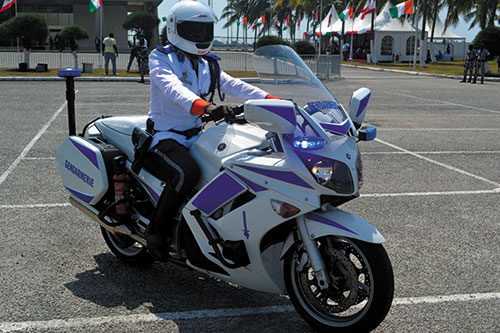
• Armament: Handguns MAC 50 Automatic Pistol (AP), MAB P 15 AP, Glock AP, revolver MR13, Smith and Wesson, Taurus, Mini Uzi - Automatic precision weapon Vector MNSS, sniper Dragonov, SIG 542 of 7,62 mm marksman - Assault rifle Pump-action shot gun calibrates 12 model 30 R-ARMSCOR cut but short barrel; MATT PM 49; SIG 540; SIG 542; COIT M16; Kalashnikov fixe butt (AK47), T56, T56-1, T56-2, T81-1 – Support weapon AA 52, FM T80, Russian Machine gun 12,7 mm, Machine gun KPVT 14,5 mm, RPG7, 60 mm Mortar, 81 mm, 82 mm, ZU on 23-2, ZU on 23-4.
• Vehicles: Toyota doubles cabin 4x4, Nissan doubles cabin 4x4, Toyota 4x4, Nissan 4x4, Hyundai 4x4, Hyundai coach, KIA 4x4, Ford doubles cabin 4x4, Mitsubishi doubles cabin 4x4 - tactical vehicles: P4 Peugeot, Acmat /VLRA, Acmat / ALTV, Toyota Land Cruiser, TRM 2000 - motorcycles: BMW 1200, Yamaha FJR 1300 - armoured vehicles VAB, ELAND, RG12, MAMBA, BTR 80, BRDM, BMP-1.
• Nautical means: inflatable boat Zodiac, 12 meters speedboats Beacher.
Cooperation
The Ivory Coast Gendarmerie maintains excellent relations with the French Gendarmerie as well as all Member States of ECOWAS, in particular the ECOWAS Member states. This cooperation is translated by a France constant support in training and through exchanges of trainees with the African Gendarmeries. Besides, it is a member of the African Gendarmeries Organization (AGO) and participates regularly in the various meetings.
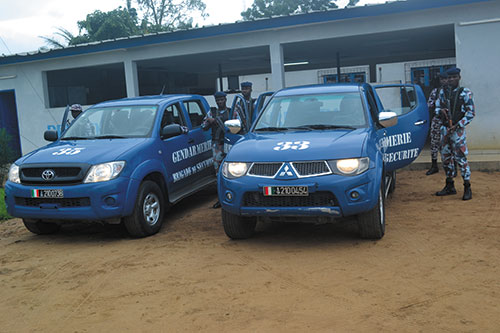
© The iconography was provided by the concerned gendarmeries

